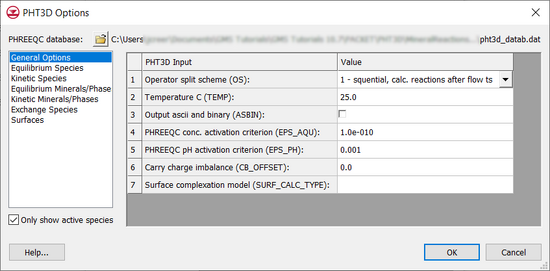GMS:PHT3D: Difference between revisions
From XMS Wiki
Jump to navigationJump to search
| Line 18: | Line 18: | ||
PHT3D requires as part of its input a PHREEQC database file. The species that can be included in the simulation depend on the contents of the PHREEQC database file. The browser button near the top of the ''PHT3D Options'' dialog allows the user to select a PHREEQC database file. GMS will parse the contents of this file and make available the species listed in the file. The user also has the option to select a PHT3D-PHREEQC interface file. When an interface package file is chosen GMS assumes that the PHREEQC database file is in the same directory with the name pht3d_datab.dat. In addition to parsing the PHREEQC database, the interface file is also read and any options that are specific to the species are imported. | PHT3D requires as part of its input a PHREEQC database file. The species that can be included in the simulation depend on the contents of the PHREEQC database file. The browser button near the top of the ''PHT3D Options'' dialog allows the user to select a PHREEQC database file. GMS will parse the contents of this file and make available the species listed in the file. The user also has the option to select a PHT3D-PHREEQC interface file. When an interface package file is chosen GMS assumes that the PHREEQC database file is in the same directory with the name pht3d_datab.dat. In addition to parsing the PHREEQC database, the interface file is also read and any options that are specific to the species are imported. | ||
The PHREEQC database file can contain many species. When a user is only using a small subset of the available species in the database it is useful to only show the species that are active (in use). The ''Only show active species'' check box hides all of the species that are not active. | The PHREEQC database file can contain many species. When a user is only using a small subset of the available species in the database it is useful to only show the species that are active (in use). The ''Only show active species'' check box hides all of the species that are not active. | ||
